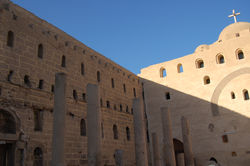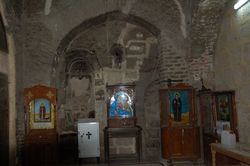
 |  |
|---|---|
 |  |
 |  |
 |  |
 |  |
 |  |
Out from the city of Sohag, lies a few interesting, yet modest, monasteries. Their names, the "Red" and the "White" are effective in creating visitors' interests.
White Monastery is names so for the limestone walls of the surviving church, which in some ways resembles a pylons of a Pharaonic temple. This monastery, founded actually be the uncle of St. Shenouda, St. Pigol, lies 4 1/2 kilometers south of Sohag, with the Red Monastery very nearby.
This monastery was built around 400 AD by St. Shenouda. It took many stones from an ancient Egyptian temple that was built in white limestone.
At its peek, after St. Shenouda became the monastery's abbot, there were some 4,000 monks and nuns, and the grounds of the monastery covered some 12,800 acres. Facilities included kitchens, storehouses and monk's cells, the remainder of which can still be seen to the north, west and south of the church. According to ancient documents, during the middle ages there was also a second church dedicated to the Virgin Mary and a keep.
After St. Shenouda, the monastery continued to be very active up until around the middle of the eighth century, when without the strong leadership it had enjoyed in it's early period, and under heavy taxation that was imposed about this time in Egypt, it fell into decline. Actually, the taxes of this period put many monasteries out of existence, and it is a tribute to the strength of the While Monastery that it survived at all.
What survives of the original monastery is only the Basilica style church complex. It had six entrances, with three in the north, south and west walls, and the other three south of the west wall, east of the south wall and east of the north wall. As mentioned earlier, outwardly the church much resembles an ancient Egyptian Temple.
The body of the church is now an open courtyard and contains a nave flanked by two isles. To realize the grand style of this 5th century basilica, one needs only to observe the dimension of this open courtyard. It measures 172 feet long by 76 feet wide, of which the nave occupies half that width.
The church is build using various materials, but the original construction used white limeston set in mortar with no bonding. The source of this material was probably from nearby ancient Egyptian temples. the original nave columns are made of marble or granite and the paving of the nave is of limestone or granite slaps. Originally there was a wood roof, but that is now of burnt brick.






